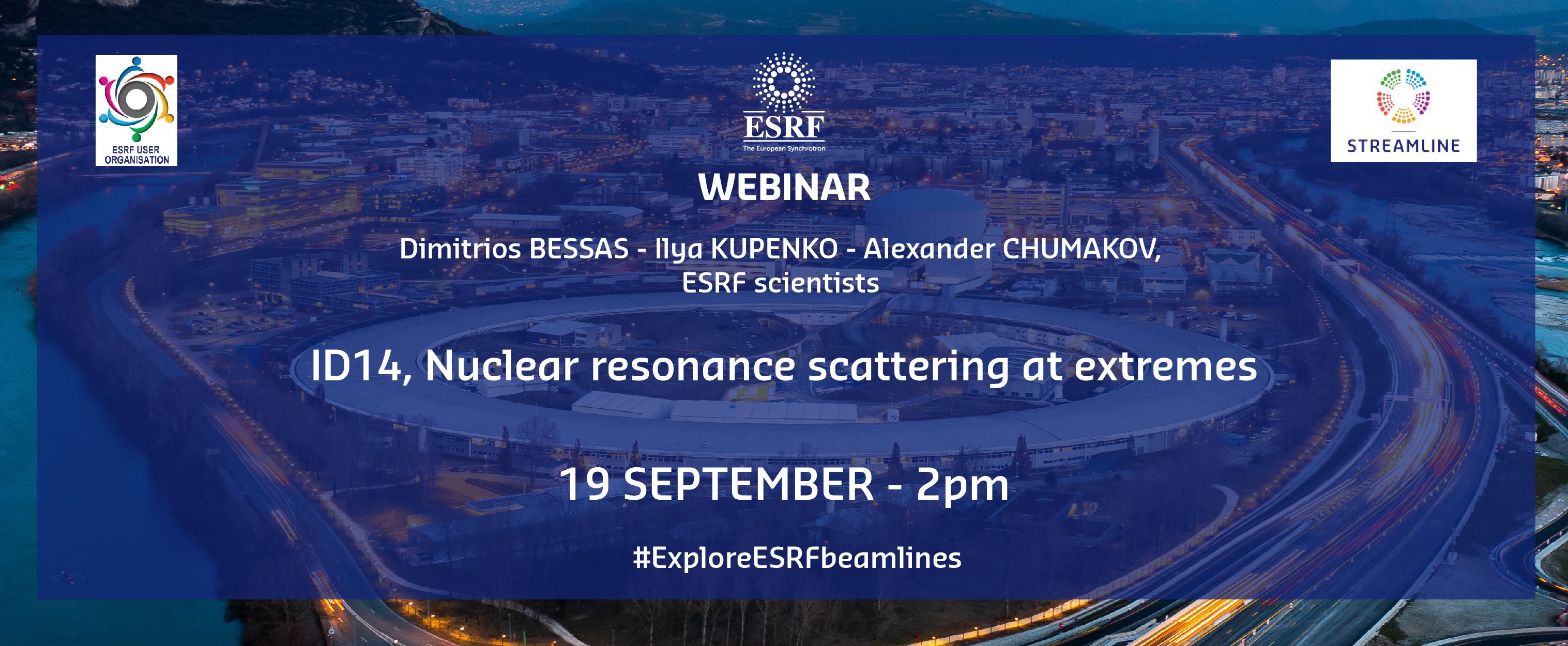EXPLORE ESRF BEAMLINES - ID14 Nuclear resonance scattering at extremes - Dimitrios Bessas - Ilya Kupenko - Alexander Chumakov
 ID14 Nuclear resonance scattering at extremes
ID14 Nuclear resonance scattering at extremes
Dimitrios Bessas - Ilya Kupenko - Alexander Chumakov
ABSTRACT
A. I. Chumakov1, D. Bessas1, I. Kupenko1
1 European Synchrotron Radiation Facility, Grenoble, France
Nuclear Resonance Scattering of synchrotron radiation is a well-established scattering process for obtaining information relevant to physicochemical properties of compounds/complexes containing the so-called Mössbauer active isotopes, i.e., stable isotopes with nuclear transitions that can be favorably excited using synchrotron radiation or alternatively a radioactive source.
The valence and the spin state, the local electronic environment, the magnetic state (both amplitude and direction of magnetic field), and the lattice dynamics may be revealed ex-situ/in-situ/operando using Nuclear Resonance Scattering of synchrotron radiation.
Nuclear Resonance Scattering comprises mainly of Synchrotron Mössbauer Source (SMS) spectroscopy [1,2], Nuclear Forward Scattering (NFS) [3,4], Nuclear Inelastic Scattering (NIS) [5,6], as well as complementary methods such as Synchrotron Radiation Perturbed Angular Correlation (SRPAC) spectroscopy [7,8] and Time Domain Interferometry (TDI) [9,10].
These methods are particularly useful when:
(i) conventional Mössbauer spectroscopy is impractical, e.g., a relevant radioactive source does not exist or its lifetime is too short for practical applications,
(ii) the experimental setup requires a collimated or a small-size beam, e.g., thin films or microscopic samples, including samples under high pressure,
(iii) element-specific lattice dynamical characterization is required.
In this webinar the principle of nuclear resonance scattering of synchrotron radiation will be given, the characteristics of the newly built nuclear resonance beamline ID14 at ESRF will be discussed, and representative examples of NFS, SMS, and NIS, will be presented.
References
[1] G.V. Smirnov, U. van Bürck, A. I. Chumakov, A. Q. R. Baron, R. Rüffer, Phys. Rev. B 55 (1997) 5811.[2] V. Potapkin, A. I. Chumakov, G. V. Smirnov, J.-P. Celse, R. Rüffer, C. McCammon, L. Dubrovinsky, J. Synchrotron Rad. 19 (2012) 559.
[3] J. B. Hastings, D. P. Siddons, U. van Bürck, R. Hollatz, U.Bergmann, Phys. Rev. Lett. 66 (1991) 770.
[4] U. van Bürck, D. P. Siddons, J. B. Hastings, U. Bergmann, and R. Hollatz, Phys. Rev. B 46 (1992) 6207.
[5] M. Seto, Y. Yoda, S. Kikuta, X. W. Zhang, and M. Ando, Phys. Rev. Lett. 74 (1995) 3828.
[6] W. Sturhahn, T. S. Toellner, E. E. Alp, X. Zhang, M. Ando, Y. Yoda, S. Kikuta, M. Seto, C. W. Kimball, B. Dabrowski, Phys. Rev. Lett. 74 (1995) 3832.
[7] A. Q. R. Baron, A. I. Chumakov, R. Rüffer, H. Grünsteudel, H. F. Grünsteudel, O. Leupold, Europhys. Lett. 34 (1996) 331.
[8] I. Sergueev, U. van Bürck, A. I. Chumakov, T. Asthalter, G. V. Smirnov, H. Franz, R. Rüffer, and W. Petry, Phys. Rev. B 73 (2006) 024203.
[9] A. Q. R. Baron, H. Franz, A. Meyer, R. Rüffer, A. I. Chumakov, E. Burkel, W. Petry, Phys. Rev. Lett. 79 (1997) 2823.
[10] G. V. Smirnov, U. van Bürck, H. Franz, T. Asthalter, O. Leupold, E. Schreier, W. Petry, Phys. Rev. B 73 (2006) 184126.



